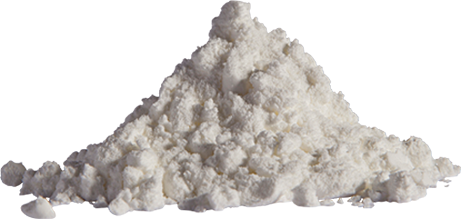STARCH
Overview:
Starch is the most common carbohydrate in the human diet and is contained in many staple foods. The major sources of starch worldwide are cereals (rice, wheat, and maize) and root vegetables (potatoes and cassava). As an additive for food processing, food starches are typically used as thickeners and stabilizers in foods such as puddings, custards, soups, sauces, gravies, pie fillings, and salad dressings and to make noodles and pastas.
Papermaking is the largest non-food application for starch globally, consuming millions of metric tons annually. Another large non-food starch application is in the construction industry, where starch is used in the gypsum wall board manufacturing process. Starch is used in the manufacture of various adhesives or glues for book-binding, wallpaper adhesives, paper sack production, tube winding, gummed paper, envelope adhesives, school glues and bottle labeling.
Clothing or laundry starch is a liquid that is prepared by mixing a vegetable starch in water and is used in the laundering of clothes. The product is sold in aerosol cans for home use.
Characteristics and Challenges:
Generally, starches are dry, fine, powdery substances. Starches have different flow characteristics, depending on the plant source from which it is derived and other variables. Moisture content critically affects the flowability of this material. Dry starches have a tendency to flow out of pipes or screw conveyors when the conveyor stops. However starches with a higher moisture content may clump and be difficult to move.
Starch that has been stored for long periods of time without movement or agitation may not flow easily. Conversely, repeated transfers of starch from one container to another also affects the flowability as fines tend to separate out of the bottom with each transfer, changing the particle distribution. Starch also settles quickly and spoils easily.1
Faulty conveying of starch in the manufacturing and/or packaging processes will not only eat away at production efficiency through unnecessary downtime, cleaning, maintenance and product loss, but it can also be dangerous.
Starch dust can produce an extremely explosive mixture with air. All motors in confined areas must have explosion proof ratings. All conveying equipment and storage silos must be grounded to prevent static electricity. A static relief valve in the storage silo is also recommended in the event that a starch "bridge" collapses and causes the silo to cave in.2

To be consistently successful with flow promotion of starch, operators must take into account the vessels used to transport starch to their processing sites. Starch cakes and packs easily and tends to fluidize, meaning the fine starch particles take on characteristics of a liquid.
Moisture content is the most critical property that affects the flowability of starch. Starch shipped by railcar or stored for extended periods in silos stands a greater potential for moisture exposure. As a result, if the starch is being pneumatically conveyed into a processing system, the blower used to move the air line must be sized to meet the system. If ambient or storage vessel moisture is an issue, an inline air dryer that is powerful enough to extract the moisture is an effective aid in maintaining the flow of starch.
If the starch arrives at the processing facility in large bulk bags, the frames used to discharge the bags usually require additional accessories to completely empty the bags and prevent any fine starch particles from escaping into the surrounding atmosphere. If the starch is packaged in smaller (>50 lb) bags, a bag-emptying station with a dust hood, filtration devices and a pneumatic pulse cleaner may be sufficient to support the manual unloading of the material.
Starch will tend to "rat hole" or bridge in hoppers, completely blocking the flow of the material, causing a shutdown while it is removed and elevating the risk of starch dusting or spillage. Feed hoppers should be designed with proper geometry, with as smooth a surface as possible and may need to incorporate devices such as air fluidizers or vibrators to dislodge starch from hopper walls or mechanical agitators to promote flow. A hopper screen above the receiving vessel will help protect the operators if the starch is being dumped manually into a hopper that is equipped with agitating devices.
If a flexible screw is being used to convey the starch, it is important to use a screw that matches the starch's characteristics and other application requirements. Generally a screw with a wider, flatter surface than the standard-sized screw is necessary for moving starch up an incline.
Flexicon Applications:
Consultation with a Flexicon specialist will help you decide if a flexible screw or pneumatic solution best fits your starch application. Flexicon's expert design and engineering staff will weigh each parameter and recommend the best solution for you. Upon request, Flexicon's test lab will simulate your starch handling applications before the system is installed in your plant.
A Flexicon bulk handling system, designed and engineered for a UK packaging firm, protected its workers, prevented plant contamination and reduced material waste.
Flexicon's Dust Suppression and Collection Systems ensure proper containment of starch throughout the conveyance process. Flexicon's High-Flow Hopper, purpose-built for flexible screw conveyors, increases the flow of both free- and non-free-flowing bulk materials while eliminating or decreasing the amount of residual material in the hopper as well as the need for flow promotion devices, and is perfectly suited for starch handling.
Flexicon's product line of advanced flow promotion conveyors, high-flow hoppers, deaeration/densification decks and a host of other components and accessories are proven performers that promote flow while reducing degradation, dusting and/or the separation of blends comprised of disparate particles.
Related Articles on Starch:
1 Hippleheuser: Comparisons of Starch Handling Characteristics and Starch Handling Equipment for Papermakers, ©1990, AE Staley Manufacturing Company
2 Ibid
Sources: Where noted. All other information courtesy of Flexicon Corporation.